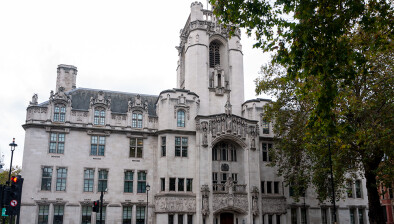Michael Foran: The law as it is

Dr Michael Foran
Dr Michael Foran responds to a critique of his commentary on some upcoming cases.
Robin White has kindly offered a response to a recent article I wrote about two upcoming cases concerning the meaning of sex within the Equality Act. I welcome the caution concerning the dangers of analysing the law from a political standpoint. When discussing a topic as contentious as this, it’s best to stick to the law.
Ms White is correct that discrimination law in the UK begins with a general principle of equal treatment. But this does not mean that this general norm holds sway in all areas. There are exceptions contained in Schedule 3 which expressly allow for single characteristic services, including single-sex services. When operating within the realm of the Schedule 3 exceptions, the norm is not equal treatment, it’s unequal treatment in order to maintain the character of the service as single-sex, for example.
While Ms White is right that the general principle is ordinarily one of inclusion, she cannot ignore that where Schedule 3 is engaged, the norm shifts to being one which is expressly designed to permit differential treatment on the basis of sex and/or gender-reassignment in order to maintain a given service as single-sex in nature. It’s against this general norm of permitted exclusion that any proportionality test must be read.
Ms White is therefore wrong to presume the default is that trans men must be accommodated in male facilities and trans women in female facilities. Whether a trans woman can be accommodated within a female only facility depends first on whether the protected characteristic of sex within the Equality Act treats trans women as female. It depends secondly on whether it treats all trans women as female or only some. Finally, it depends on whether the service provider has chosen to rely on the relevant exceptions and, relatedly, whether the exclusion in this context satisfies the tests for justifying sex discrimination if the trans women is classed as male or gender reassignment discrimination if she is classed as female.
So it matters for all of this whether the individual seeking access to a single-sex space is recognised for the purposes of the Equality Act as male or female. Corbett v Corbett [1970] 2 All ER 33 is the authoritative statement of the common law position on this, which I set out in my initial article. In brief, for those legal purposes where sex matters, it’s biological sex that the law recognises. This was affirmed in both Bellinger v Bellinger [2002] 2 AC 467 and A v Chief Constable of West Yorkshire Police [2004] UKHL 21 as the correct position in domestic law. In A, Lord Bingham, referencing Corbett, states that
“That case, it is true, concerned the capacity of a male-to-female transsexual to marry. But the Court of Appeal (Criminal Division) applied the same rule to gender-specific criminal offences in R v Tan [1983] QB 1053. … there was nothing in English domestic law to suggest that a person could be male for one purpose and female for another, and there was no rule other than that laid down in Corbett and R v Tan.”
Similarly, Lord Rodger noted at [19] that the correct statement of the domestic law of the United Kingdom on this question is that even a trans woman who has undergone full gender reassignment surgery remains male. Lady Hale confirms this position at [30] and [33]. A is unequivocal authority for the proposition that in domestic law, subject to legislative change, an individual’s sex is fixed at birth and tied to whether they are biologically male or female.
Ms White is therefore incorrect to claim that “the House of Lords ruled that a male-to-female transitioner who was ‘for all practical purposes’ of the acquired gender should be so treated”. That claim misstates the ratio of this case and fails to adequately distinguish between the domestic legal context and the European legal context. At this time, both European Community law and the jurisprudence of the European Court of Human Rights established rules relating to trans people.
European Community law demanded that protection be afforded for discrimination based on gender reassignment. This was qualified where certain exceptions were set out, most notably for the purposes of A the exception permitting employers to set certain jobs aside for non-trans women or men where there is an occupational requirement such as privacy or intimacy.
The jurisprudence of the European Court of Human Rights, specifically the case of Goodwin v United Kingdom established the right of post-operative transsexuals to be legally registered in their acquired gender on their birth certificates and for the information about their biological sex to be kept private in some contexts.
There are two important points to make about both of these strands of legal development. The first is that recognition in one’s acquired gender was, at that time, tied to surgery. The decision of the House of Lords in A was that, as far as domestic law is concerned, sex means biological sex; as far as European law was concerned, post-operative transsexuals are entitled to be recognised in their acquired gender in certain circumstances, but by no means all. It was common ground that this recognition did not cover areas where biological sex was an essential aspect of an area of law such as sexual crimes or occupational requirements.
Ms White would therefore do well to exercise caution before accusing others of omitting important analysis when discussing this case. The full statement of Lord Bingham, only partially quoted by White refers to “the acquired gender of a post-operative transsexual who is visually and for all practical purposes indistinguishable from non-transsexual members of that gender”. The reference to indistinguishability was a qualifier, applying the principle of recognition only to those post-operative trans people who were also for all practical purposes indistinguishable from a non-trans person. It did not have anything to say about trans people who have not undergone surgery. To read that sentence, take it out of its legal context, cut it in half and use it to claim that the House of Lords held that any trans person who ‘passes’ has a right to be treated in law as their acquired gender is – to put it charitably – quite an omission.
The second point to make here is that these cases were informed by the position in European law at the time of A. In the absence of domestic legislation, courts were under an interpretative obligation to read in those specific rules as they relate to post-operative trans people. The European obligations are not a statement of domestic law. They place duties upon the United Kingdom as a whole to, however it so chooses, incorporate these principles into its domestic law. When the Gender Recognition Act was passed, it constituted definitive domestic incorporation of these principles, reflecting legislative choices to meet these obligations in a way that balances the rights of others.
One important implication of the GRA is that it removed the gatekeeping of legal recognition of changed sex behind a requirement to have undergone surgery. Against the developing backdrop of the European jurisprudence, that can only be correct, but it leaves open two important questions:
- What is the situation for trans people who do not have a GRC?
- What is the effect of having a GRC on the operation of the single-sex exceptions in the Equality Act?
On the first question, we know for a fact that a trans person without a GRC is legally classed as their biological sex. The High Court in R (Green) v Secretary of State for Justice [2013] EWHC 3491 held at [68] that “until there is a GRC, [Green] remains male … Male to female transsexuals are not automatically entitled to the same treatment as women – until they become women”. This case concerned a trans woman without a GRC and so the finding that Green is male is authoritative and binding precedent that being protected under the characteristic of gender reassignment does not in itself entitle trans people to be treated as if they had legally changed sex. This was another omission from Ms White’s response.
There is an open question as to whether the protected characteristic of sex is modified by a GRC for the purposes of the Equality Act, as a whole or in part. The High Court in Green seemed to imply that, had Green been in possession of a GRC, she may have been entitled to be treated as a woman for the purposes of the Equality Act. This is supported by the decision of Lady Haldane in Petition of For Women Scotland [2022] CSOH 90 (FWS2).
But the implication in Green is obiter and the decision in (FWS2) is from the Outer House of the Court of Session and so cannot bind or disapply the finding of the Inner House in For Women Scotland v The Lord Advocate and the Scottish Ministers [2022] CSIH 4 [36] (FWS1), that:
“when one speaks of individuals sharing the protected characteristic of sex, one is taken to be referring to one or other sex, either male or female. Thus an exception which allows the Scottish Parliament to take steps relating to the inclusion of women, as having a protected characteristic of sex, is limited to allowing provision to be made in respect of a “female of any age”. Provisions in favour of women, in this context, by definition exclude those who are biologically male.”
There is clearly a high degree of uncertainty on this matter and Ms White is free to disagree with Lady Dorrian. But she cannot omit or ignore this decision in her analysis if her argument is that there is no definition of male or female in the Act. True that may be, but there is precedent that female by definition excludes biological males.
Lady Haldane attempted to distinguish this case, arguing that she does not accept that FWS1 is authority for the proposition that “sex” for the purposes of the Equality Act means only biological sex. That may or may not be persuasive, given the express wording in paragraph 36 quoted above. Nevertheless, conflicting decisions are coming from the judiciary and it is becoming increasingly obvious that the precise interaction between the GRA and the Equality Act is unclear.
My view is that many provisions relating to sex within the Equality Act are nonsensical if they mean sex as modified by a Gender Recognition Certificate. Ms White takes the opposite view and I welcome a constructive debate, free from hyperbole or personalised attacks.
Dr Michael Foran is a lecturer in public law at Glasgow University









